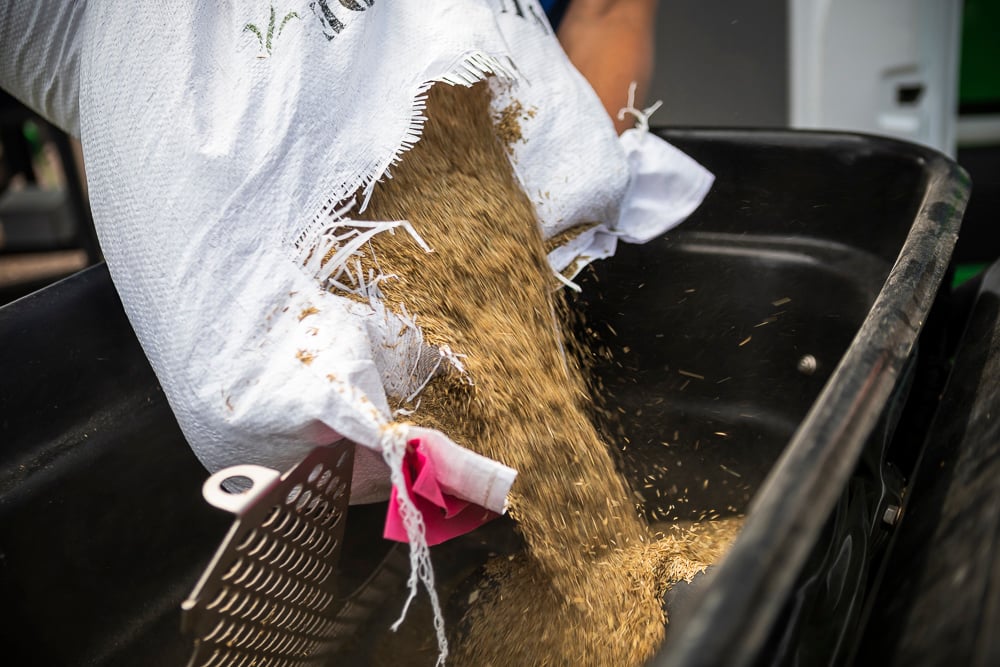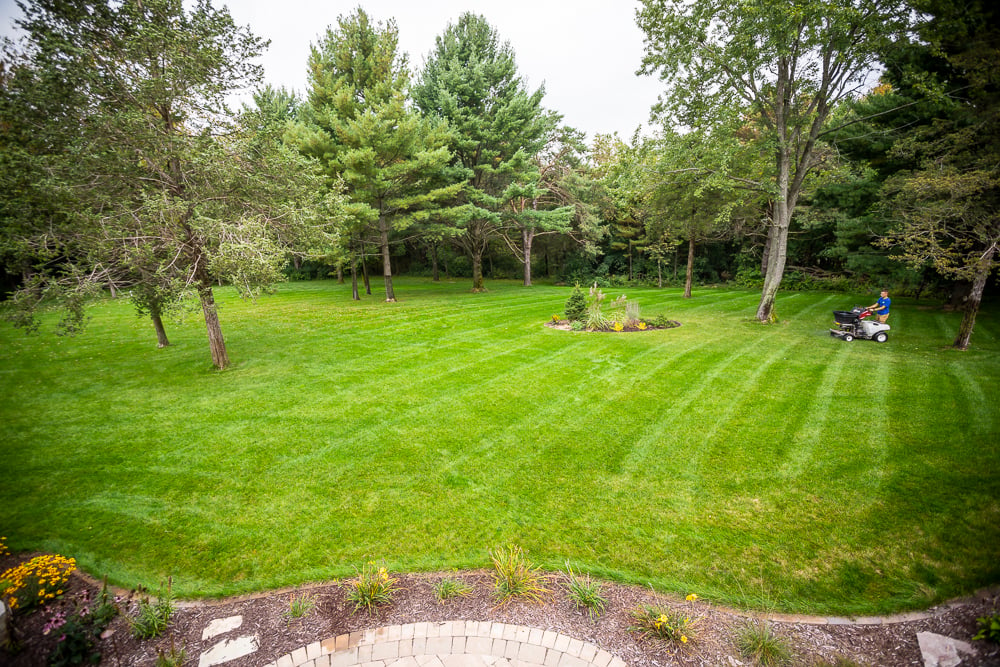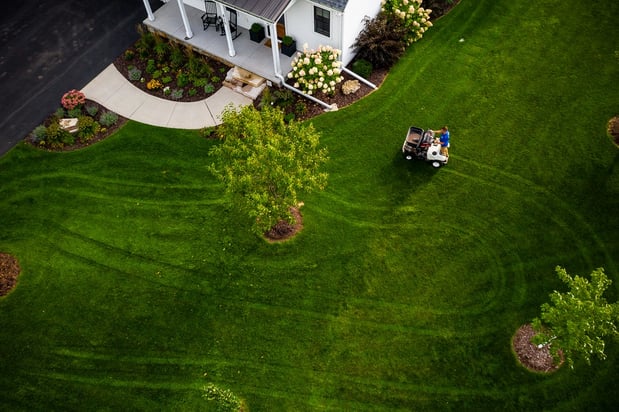Whether your dog dug up a patch of yard, drought killed a spot or you accidentally scalped it with the lawn mower, there are plenty of reasons a dead area might appear in your lawn.
Overseeding is a great way to fill in areas that appear less lush, but selecting the right type of grass is crucial. So which one is right for your Eau Claire, WI, lawn?
Jump to Section
- What do ‘cool season grass’ and ‘warm season grass’ mean?
- What are the best grass types for Eau Claire, WI?
- How do I buy the best grass seed in Wisconsin?
- How do I overseed my lawn?
- Lawn Seeding FAQ
- Trust Your Lawn Seeding to RainMaster
The first thing to consider is your climate. In the same way that palm trees might grow well in Florida but can’t survive Wisconsin, different grasses will thrive in different areas.
The big decision is between ‘warm-season’ and ‘cool-season’ grasses. From there, it’s more of a preference, so let’s start with the basics.
What do ‘cool-season grass’ and ‘warm-season grass’ mean?
The biggest difference between cool-season and warm-season grasses is the time of year they are actively growing.
Cool-season grasses get their start in late winter or early spring, so you’ll see them start to green up and send out new shoots earlier in the year. They set seed in the spring or early summer and then go dormant when the weather heats up. As fall brings cooler temperatures back, cool-season grasses resume growing and continue until the ground freezes.

Warm-season grasses wait until the weather warms up more to get started, sending out new leaves in late spring or early summer. These set seeds in summer or early fall and go dormant in winter.
So, basically, cool-season grass grows during cooler temperatures, while warm-season grass gets going in warmer temperatures.
That difference in growing time gives each a distinct advantage when it comes to handling different conditions. Cool-season grasses are better equipped to handle lower temperatures, frost and lower light levels.
Warm-season grasses, on the other hand, need more light and have a lower tolerance to frost. Like the name suggests, they’re happier in higher temperatures.
What are the best grass types for Eau Claire, WI?
Now that we know which is which, you might be asking yourself, 'Do I need cool or warm-season grass?'
The best grass types for the Eau Claire, WI area are cool-season grasses, as they withstand low winter temperatures the best. While you might like the characteristics of warm-season grasses, they just won’t thrive in Wisconsin weather.
At RainMaster, we overseed with a mix of Kentucky bluegrass, perennial ryegrass, and fescue, all of which are cool-season grasses best suited to our climate.
While you can overseed with just one type of cool-season grass, applying a blend helps fight disease, drought, traffic and stress in the lawn.

If you plant 100% of any one type of grass, the whole yard will struggle, as each type is more susceptible to different diseases and stressors. And since most lawns have a mix of shade and sun, a blend ensures the lawn thrives in both.
How do I buy the best grass seed in Wisconsin?
When it comes to grass seed, there’s always a good option, a better option and a best option. Bags of lower-end seeds will have fillers or what’s often called ‘inert matter.’
A better option might include other fillers, such as a water-absorbent coating, which sounds high-tech but means you’re getting less actual grass seed.
The best option will contain more grass seed and less inert matter. It’s more expensive per bag, but you’ll be getting more of what you want. Be sure to review the ingredients to make the best decision for your lawn.
How do I overseed my lawn?
If you’re overseeding your own lawn, there are some other keys to success you should consider. Make sure to follow the bag instructions and put down enough seed. If you need 3 pounds and only put down a pound and a half, you’re going to be disappointed with the results.
Once the seed is planted, a specific and consistent watering schedule is required to ensure it sprouts and takes root.

We’re talking about two to four times per day, so it’s no easy feat. A timed watering system is worth considering when watering new seed.
Lawn Seeding FAQ
Looking for some more info? Check out these frequently asked lawn care questions for more insight into proper seeding for Upper Midwest lawns.
Can you mix cool-season and warm-season grass?
The short answer is no, you shouldn’t mix the two types of grasses. Because they have different textures and colors, mixing cool- and warm-season grasses results in a patchy lawn that lacks the uniform appearance you desire.
In some transitional zones in the middle of the country, a mix works to help lawns stay green year-round, but in general, you don’t want to mix the two since they’re so different.
Which grasses are cool-season and which are warm-season?
Cool-season grasses include Kentucky bluegrass, perennial ryegrass, and fine and tall fescues.

Warm-season grasses include bermudagrass, Bahia grass, centipede grass, and zoysia grass.
What is the ideal temperature range for cool-season vs warm-season grass?
Cool-season grasses grow best when temperatures are between 65 and 75 degrees F (and the soil hits 40-45 degrees F). Warm-season grasses grow best at 90-95°F (and the soil is 60-65°F).
Can you plant cool-season grass in the fall?
Yes! In fact, the best time to put down cool-season grass seed is early fall. Since they prefer cooler temperatures, you should wait until daytime temperatures are between 60 and 75 degrees, and the soil temperature is between 50 and 65 degrees.
Germination typically takes a week to 30 days, but you’ll need to wait two months before mowing. And it can take one to two years before it’s considered fully mature.
Looking for a Lawn Care Partner? Choose RainMaster
From selecting the right grass to applying the ideal amount of seed to maintaining consistent watering, overseeding a lawn can be a challenging task. If you’re ready to let the experts take care of it for you, RainMaster is standing by to help!

Consider it a team effort. Let’s create a custom plan for your Eau Claire, WI lawn - you can choose from three different levels of lawn care programs, based on the results you’d like, how fast you want to see results, and your budget.
You deserve exceptional customer experiences, skilled professionals on your lawn, and premium products that deliver results.
Let’s create a greener lawn together. Request a quote today! We’ll review your lawn care options together so you can make a great choice.




